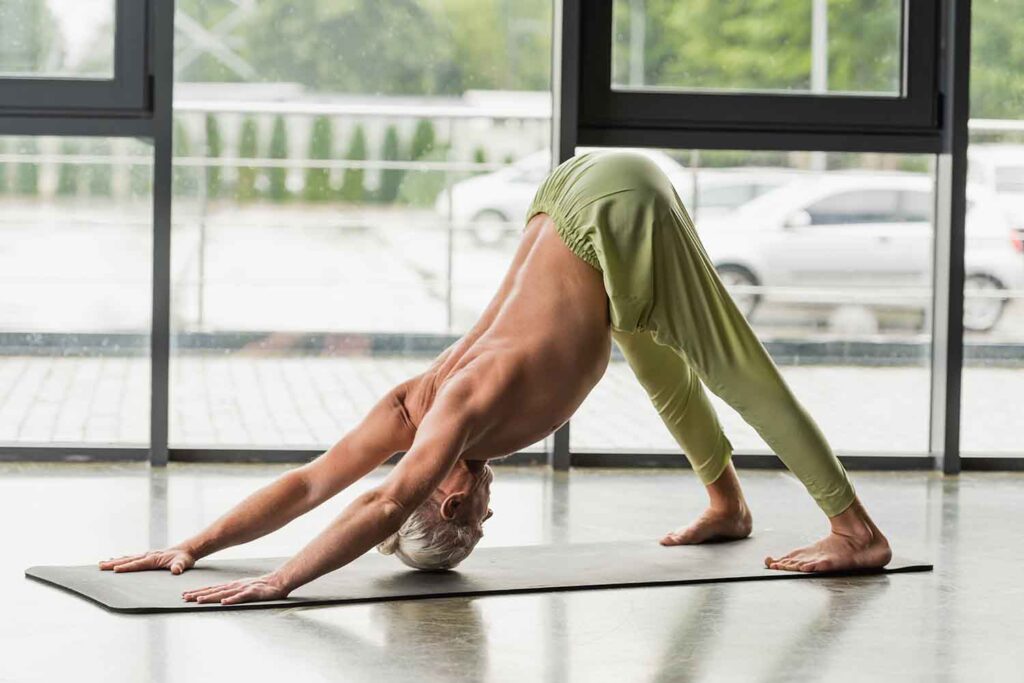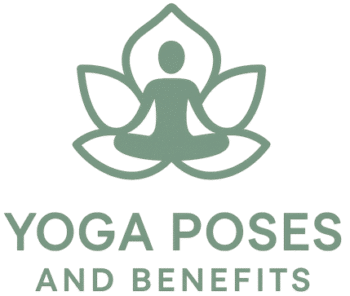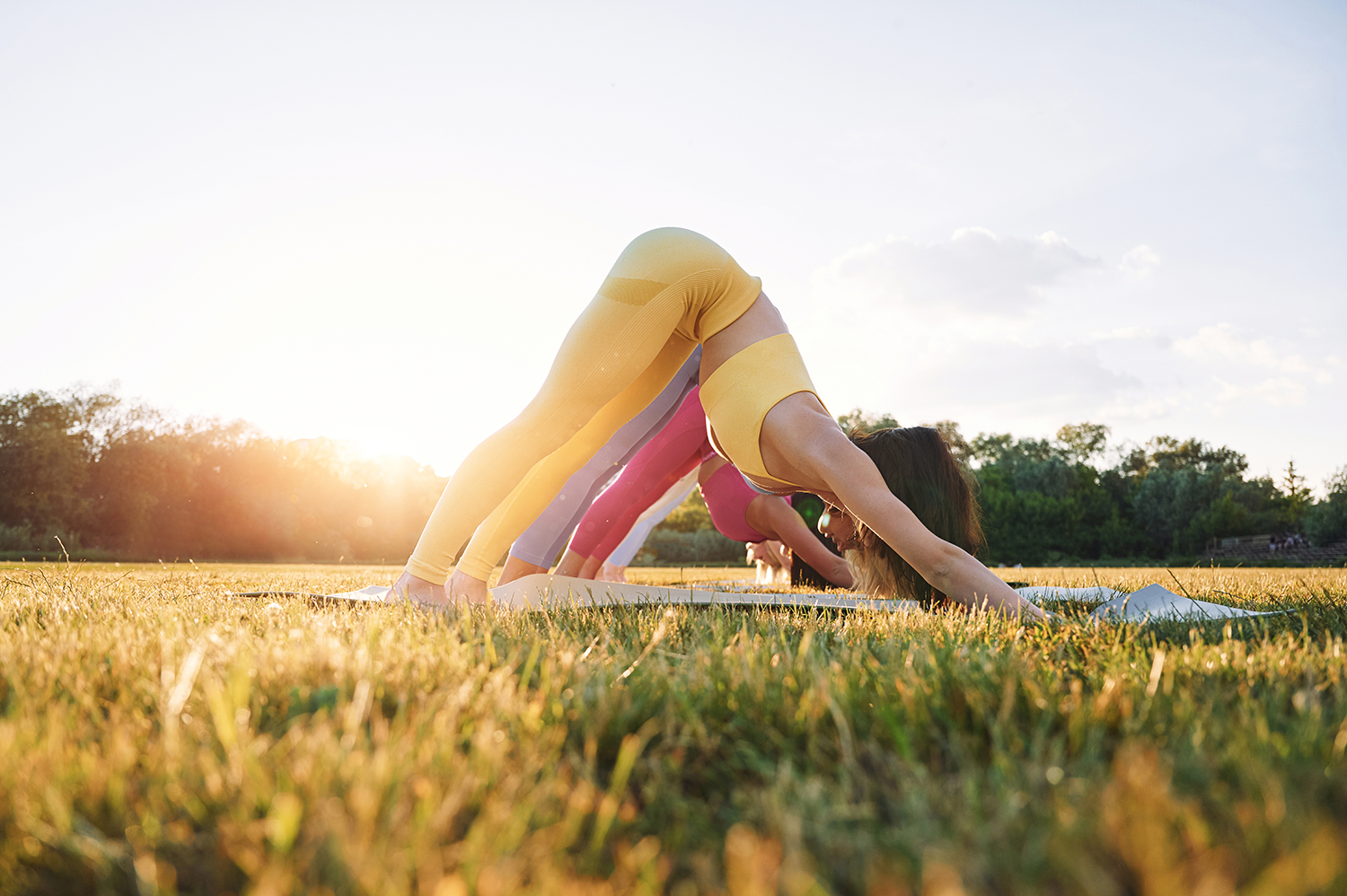Downward-Facing Dog (Adho Mukha Svanasana) is one of the most iconic poses in yoga, offering a full-body stretch that strengthens and rejuvenates the practitioner. This foundational posture helps stretch the hamstrings, calves, and shoulders, while also building strength in the arms and core. It is often used as a transitional pose but also functions as a resting and rebalancing point in many sequences. Downward Dog creates length and alignment in the spine, encouraging decompression and flexibility.
Other Names for Downward-Facing Dog Pose
Here are some of the common names for Downward-Facing Dog in yoga:
- Adho Mukha Svanasana (Sanskrit)
- Down Dog
- Inverted V Pose
How to Do Downward-Facing Dog in Yoga
To perform Downward-Facing Dog, follow these steps:
- Begin in a tabletop position with your wrists directly under your shoulders and knees aligned with your hips.
- Spread your fingers wide, pressing firmly into the mat through the base of your fingers and knuckles.
- Tuck your toes under, exhale, and lift your hips toward the ceiling, straightening your legs into an inverted V shape.
- Keep your spine long by pushing through your hands and pulling your hips back. Allow your head to relax, aligning your ears with your upper arms.
- Bend your knees slightly if needed to maintain length in the spine, and press your heels toward the floor.
- Hold the pose for 5–10 breaths, maintaining steady, deep breathing.
Variations of Downward-Facing Dog Pose
Downward-Facing Dog offers numerous variations to challenge or accommodate different levels of flexibility and strength:
- Three-Legged Downward Dog (Eka Pada Adho Mukha Svanasana): Lift one leg into the air, keeping your hips square. This intensifies the stretch in the standing leg and builds strength in the arms.
- Puppy Pose (Uttana Shishosana): Lower your knees to the mat and stretch your arms forward, keeping your hips lifted. This gentler variation allows for a more restorative shoulder and chest stretch.
- Downward Dog Split: From Downward Dog, extend one leg straight into the air, opening the hips and adding a balance challenge.

Modifications for Downward-Facing Dog Pose
To make Downward-Facing Dog more accessible, consider these modifications:
- Use a Chair or Wall: If you have tight hamstrings or shoulders, practice Downward Dog with your hands on a chair or against a wall, focusing on lengthening the spine.
- Bend the Knees: If you find it difficult to keep your spine long, slightly bend your knees to release tension in the lower back and allow for more mobility.
- Rest on the Forearms: For those with wrist pain, practice Dolphin Pose by lowering onto your forearms, keeping the same basic structure as Downward Dog.
Contraindications for Downward-Facing Dog Pose
Take caution or avoid Downward-Facing Dog if you have the following conditions:
- Wrist Injuries: If you have a wrist injury or discomfort, modify the pose by using your forearms (Dolphin Pose) or use extra padding under the wrists.
- High Blood Pressure: This inversion may increase pressure in the head, so practice with caution, especially if you have high blood pressure.
- Eye Issues or Glaucoma: Due to the head being lower than the heart, those with eye conditions should approach this pose carefully or avoid it.
Tips to Improve Downward-Facing Dog Pose
To deepen your Downward-Facing Dog practice, follow these tips:
- Engage the Core: Keep your core muscles active to support your lower back and maintain proper alignment.
- Press into the Hands: Distribute your weight evenly across your hands and press into the mat to protect your wrists.
- Lengthen the Spine: Focus on elongating your spine by lifting your hips higher and reaching your chest toward your thighs.
- Keep Heels Heavy: Press your heels toward the mat to intensify the stretch in the hamstrings and calves, even if they don’t touch the floor.
- Relax the Neck: Avoid straining the neck by keeping your gaze toward your legs or the floor, allowing your head to hang naturally.
What Muscles Does Downward-Facing Dog Pose Work?
Downward-Facing Dog engages several muscle groups, including:
- Shoulders and Upper Arms: Pressing into the mat strengthens the deltoids, triceps, and muscles around the shoulder blades.
- Hamstrings and Calves: The posterior chain, including the hamstrings and calves, receives a deep stretch, improving flexibility.
- Core Muscles: The abdominals and obliques engage to stabilize the posture and support the spine.
- Glutes and Lower Back: The gluteus muscles activate to lift the hips, while the lower back muscles lengthen.
- Feet and Ankles: The arch and muscles of the feet work to maintain stability, and the Achilles tendons benefit from the stretch.
Mental and Emotional Benefits of Downward-Facing Dog Pose
In addition to physical benefits, Downward-Facing Dog also enhances mental and emotional well-being:
- Calming and Grounding: As an inversion, Downward Dog helps calm the nervous system, promoting relaxation and stress relief.
- Improves Focus: By focusing on alignment and breath, this pose encourages mindfulness and mental clarity.
- Builds Confidence: Successfully holding this foundational pose builds confidence in one’s strength and flexibility, reinforcing a sense of accomplishment.
- Releases Tension: Stretching the back and shoulders can alleviate tension, releasing stored stress and promoting emotional balance.
Is Downward-Facing Dog Pose Suitable for Beginners?
Yes, Downward-Facing Dog is a suitable pose for beginners with appropriate modifications. New practitioners should focus on proper alignment, using bent knees and engaging the core to avoid straining the back or hamstrings. Beginners may also use a wall or blocks for support as they build strength and flexibility in the shoulders and legs.
Is Downward-Facing Dog Pose Suitable for Advanced Practitioners?
Downward-Facing Dog remains relevant for advanced practitioners, offering opportunities to deepen their practice. Advanced yogis can explore variations such as Three-Legged Dog or Downward Dog Split to challenge balance and strength. They may also focus on refining alignment, engaging the core, and holding the pose for longer periods to build endurance and mental focus.
How Does Downward-Facing Dog Contribute to a Yoga Sequence or Flow?
Downward-Facing Dog is a key transitional pose that links movements together in many yoga sequences, including vinyasa flows and Sun Salutations. It acts as a neutral position between standing and seated postures, providing a reset for the spine and shoulders. Additionally, Downward Dog can be used as a resting posture to realign and stretch the body before progressing into more dynamic poses, making it an essential pose for full-body integration and balance.
How Can I Deepen My Practice in Downward-Facing Dog?
To deepen your practice in Downward-Facing Dog, focus on the following:
- Work on Alignment: Ensure your hands are shoulder-width apart and your feet are hip-width apart to create a strong foundation.
- Engage the Entire Body: Press your palms firmly into the mat while drawing your hips upward and back to lengthen the spine.
- Refine Your Breath: Focus on deep, controlled breathing through the nose to expand the chest and engage the core, making the pose more stable and calming.
- Play with Transitions: Flow into Downward Dog from poses like Plank or Cobra to create a seamless transition that builds strength and coordination.
- Hold the Pose Longer: Gradually increase the time you spend in Downward Dog, paying attention to subtle adjustments in alignment, breath, and balance.
What Are Some Common Mistakes in Teaching Downward-Facing Dog Pose?
Here are some common mistakes to avoid when teaching Downward-Facing Dog:
- Collapsing the Shoulders: Encourage students to press their hands into the mat and lift through their shoulders to avoid sinking into the joints.
- Rounding the Lower Back: Remind students to keep the spine long and the core engaged to prevent rounding or excessive arching in the lower back.
- Tension in the Neck: Many students hold tension in the neck by trying to look forward. Instruct them to relax the neck and gaze toward their feet or legs.
- Misaligned Hands or Feet: Check that students are keeping their hands shoulder-width apart and their feet hip-width apart to ensure a stable base.
- Overstretching the Hamstrings: Instruct students to bend their knees slightly if they cannot reach the floor with straight legs to protect their lower back and prevent overstretching.
By correcting these mistakes, students will improve their form, reduce discomfort, and gain more benefits from Downward-Facing Dog.
Is a downward facing dog good for you?
Yes, the downward facing dog pose is good for you as it strengthens the arms, legs, and core while stretching the hamstrings, calves, and spine. Common in yoga practices like Vinyasa and Hatha, it promotes circulation, improves posture, and helps relieve stress and tension.
How to do a downward facing dog correctly?
To do a downward facing dog correctly, start in a tabletop position on a yoga mat, then lift your hips toward the ceiling, forming an inverted V-shape. Press through your palms and heels, engage your core, and align your spine. Common in Vinyasa and Hatha yoga, this pose stretches the hamstrings, calves, and shoulders while building strength.
What chakra is downward facing dog?
Downward Facing Dog primarily activates the Root Chakra (Muladhara) by grounding the body and engaging the legs. It also stimulates the Sacral Chakra (Svadhisthana) and the Solar Plexus Chakra (Manipura) through core engagement and spinal alignment, making it a foundational pose in yoga practices like Vinyasa and Hatha.
Why is downward dog difficult?
Downward Dog is difficult because it demands flexibility in the hamstrings, calves, and shoulders, along with core strength and proper alignment. Beginners often struggle with tight muscles or limited mobility, making it hard to form the inverted V-shape typical of Downward Facing Dog in practices like Hatha or Vinyasa yoga.
What yoga pose is good for anxiety?
A good yoga pose for anxiety is Downward Facing Dog. This foundational pose helps calm the nervous system, improve circulation, and relieve tension. Other beneficial poses include Child’s Pose and Legs-Up-the-Wall, which support relaxation and stress relief through gentle inversion and deep breathing.
How long should you hold a downward facing dog?
You should hold a downward facing dog (Adho Mukha Svanasana) for 5 to 10 breaths, typically 30 seconds to 1 minute, depending on your experience and comfort. This foundational yoga pose supports flexibility, enhances circulation, and commonly features in Vinyasa and Hatha yoga sequences.

